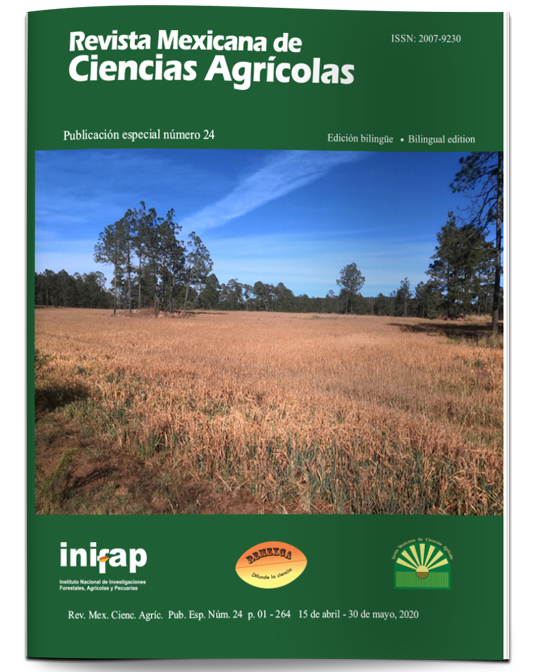Population dynamics of stems and stability index of the llanero grass
DOI:
https://doi.org/10.29312/remexca.v0i24.2355Keywords:
death rate, stem population, stem survivalAbstract
In the tropics of Mexico, grasslands are the basis for feeding ruminants. The objective of the study was to determine the density, rate of appearance, death and survival of the population of stems of the Llanero grass (Andropogon gayanus Kunt) harvested at different regrowth ages (EA: 7.14, 21, 28, 35, 42 , 49 and 56 d), in two growth periods, dry season with irrigation and rainy season. The EA (treatments) were assigned to four experimental units of 3 m2, using a randomized complete block design, with four replications. In both growth periods, the stem density increased until the 28 days of regrowth later, decreased until the end of the study with greater intensity during the dry period with irrigation compared to the rainy season (325 and 378 stems m-2, respectively). There was greater appearance and death of stems in the dry period with irrigation (97 stems 100 stems-1 week-1). The population stability index was greater or close to one during the irrigated drought, while, in rains from the 42 days of regrowth, this was less than one. In conclusion, it was obtained that regrowth ages from 7 to 28 days do not compromise the population stability of stems and favor the persistence of the grasslands. Older regrowth ages during the rains do not allow to recover the stem population, which favors population instability.
Downloads
Downloads
Published
How to Cite
Issue
Section
License
The authors who publish in Revista Mexicana de Ciencias Agrícolas accept the following conditions:
In accordance with copyright laws, Revista Mexicana de Ciencias Agrícolas recognizes and respects the authors’ moral right and ownership of property rights which will be transferred to the journal for dissemination in open access. Invariably, all the authors have to sign a letter of transfer of property rights and of originality of the article to Instituto Nacional de Investigaciones Forestales, Agrícolas y Pecuarias (INIFAP) [National Institute of Forestry, Agricultural and Livestock Research]. The author(s) must pay a fee for the reception of articles before proceeding to editorial review.
All the texts published by Revista Mexicana de Ciencias Agrícolas —with no exception— are distributed under a Creative Commons License Attribution-NonCommercial 4.0 International (CC BY-NC 4.0), which allows third parties to use the publication as long as the work’s authorship and its first publication in this journal are mentioned.
The author(s) can enter into independent and additional contractual agreements for the nonexclusive distribution of the version of the article published in Revista Mexicana de Ciencias Agrícolas (for example include it into an institutional repository or publish it in a book) as long as it is clearly and explicitly indicated that the work was published for the first time in Revista Mexicana de Ciencias Agrícolas.
For all the above, the authors shall send the Letter-transfer of Property Rights for the first publication duly filled in and signed by the author(s). This form must be sent as a PDF file to: revista_atm@yahoo.com.mx; cienciasagricola@inifap.gob.mx; remexca2017@gmail.
This work is licensed under a Creative Commons Attribution-Noncommercial 4.0 International license.



